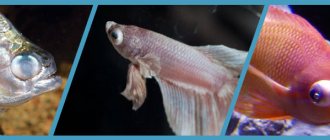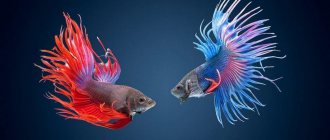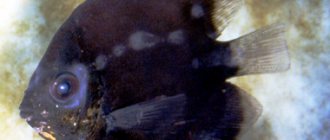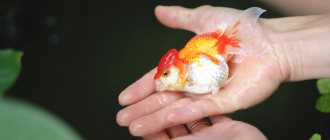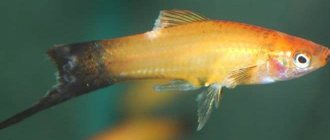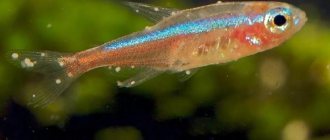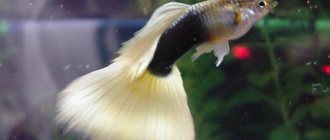4.6
(51)
Experienced aquarists know how important it is to keep the nursery clean, do timely water changes and check the levels of nitrates and phosphates. However, beginners often bypass these recommendations, which leads to various diseases.
Protruding eyes in fish (scientific name is exophthalmia) is a consequence of an infectious or fungal infection or keeping a pet in an inappropriate toxic environment. All types of fish are susceptible to it, since bulging eyes are not considered a separate type of disease, but only a cause of poor care.
This pathology affects the eyes of fish. Liquid accumulates inside or behind them, causing the apple to swell in size and literally fall out of its “orbits.” The entire visible surface of the eye becomes cloudy. If timely treatment is not taken, the fish may lose an eye, because over time the affected organ is completely separated from the body.
Despite the fact that the disease manifests itself as eye problems, it primarily affects the functioning of the kidneys and liver. An organism poisoned by environmental toxins is no longer able to cleanse itself, and kidney failure occurs in fish, which leads to similar consequences.
What is bulging eyes?
According to ichthyologists, fish eye bulge is a systemic pathological disease that affects fish eyes. It is caused by infection/fungus or environmental conditions of questionable quality (being kept in an inappropriate toxic environment). The scientific name for this phenomenon is exophthalmos.
All types of fish are susceptible to bulging eyes, since it is not considered a separate disease, but is most often a consequence of lack of proper care.
If treatment is not started in time, the fish may lose its eyes. Over time, the affected organs are completely separated from the body.
Common problems
Symptoms of the disease are associated with deterioration in appearance, impaired visual and olfactory functions, problems with the gastrointestinal tract, impaired motor functions and the respiratory system.
Rules:
- If symptoms appear in all inhabitants at the same time, then the problem is usually in the environment: poor quality water, lack of oxygen in the water, low temperature, nitrates.
- If the problem affects only one species and not the other, then infectious diseases develop in the aquarium.
- If one inhabitant is sick, then there are problems with physical, mental illnesses, old age, injuries.
Conduct a thorough examination of the sick, check the water parameters and move the sick representatives to a quarantine tank.
Lies at the bottom
The most common symptom of the disease is the betta fish lying on the bottom.
Causes:
- Old age.
- Cool water reduces the activity of tropical fish, which is why they fall into a lethargic state: they stop responding to food, stay in one place, and the betta lies on the bottom and breathes heavily. The low acceptable threshold for tropical inhabitants is considered to be a water temperature of 19–20 degrees.
- If a pet is breathing heavily and lying on the bottom after moving, moving to another, unusual environment, a new aquarium, to other inhabitants, then this is completely normal. The cockerel is just stressed. After acclimatization, the betta will become active again after some time.
- But the symptom, when the inhabitant is breathing heavily while lying on the bottom, has more dangerous causes. One of them is chemical poisoning of the body. Check water indicators using tests, move the inhabitants to a favorable environment.
Diseases:
- Dropsy is a bloated body.
- Fin rot is a white coating on the fins, their rotting.
- Ichthyophthiriasis - white spots on the skin.
- Oodiniosis is a red coating and spots on the skin.
- Gill fluke - gills are covered with mucus, parasites are visible.
- Exophthalmia - bulging eyes.
- Saprolegniosis is a white fluffy coating on the head, body, tail, similar to mold spores. Treatment with baths with salt and malachite green, antibiotics.
The course of treatment depends on the disease causing the symptom. For prevention, feed the betta fish 2 times a day in small portions, replace the water, disinfect the new soil, and do not overpopulate the aquarium.
Doesn't eat
Lack of appetite is not always caused by illness. Safe reasons include the cockerel not accepting one type of food (more often this happens with dry food). In this case, try replacing regular food with live food: brine shrimp, bloodworms, pieces of lean fish, squid. Another such reason is food particles that are too large in size, which he is unable to swallow.
It is also normal that the betta does not eat after changing food or feeding the wrong type of food (for example, if you do not feed predators with live food), or moving into the aquarium. Many species of fish do not feed during spawning and caring for fry.
If your betta takes food particles into her mouth but then spits it out without swallowing it, then she may have something stuck in her throat. Usually it is a large lump of food, a particle of soil, or a foreign object. Catch and examine the pet, it is advisable to call a veterinarian.
A sudden loss of appetite indicates possible constipation, especially if accompanied by a lack of excrement. But adult inhabitants are able to cope with it themselves; it is enough not to feed the pets for a couple of days. But fry and pets with low immunity can suffer greatly.
But usually cockerels do not eat and move little due to illness. More often, lack of appetite indicates infectious internal disorders of the body.
Common diseases of cockerels with lack of appetite:
- Ichthyophthiriasis is a disease caused by a species of ciliates and is detected when white spots appear on the pet’s skin.
- Trichodinosis is a disease caused by parasitic ciliates. Malachite baths with high temperature and aeration help.
- Mycobacteriosis is an infectious disease that affects bettas and humans. Treatment with antibiotics.
Stomach is swollen
It is not always a symptom of betta fish disease. The most common reason is overfeeding your pet. Cockerels are voracious, so they overeat easily. They need to be fed 3 times a day. If you feed with live food, then the amount of food per feeding is no more than 3 bloodworms per inhabitant. There are instructions on the amount of feeding with flakes and granules on the packaging.
One of the reasons for bloating in a betta is during the spawning period. The sides and belly of females are rounded.
Especially often, bloating precedes dropsy, when internal fluid fills the entire body.
Another common reason is the colonization of tapeworms in the body, which causes the betta’s abdomen to swell. For treatment, special agents are used, which the inhabitants swallow.
There is a high probability of internal tumor. Most often, such inhabitants cannot be saved, especially in the late stages of the disease.
Vibriosis also causes bloating of the abdomen. It is caused by Vibrio bacteria. The disease is usually transmitted in salt aquariums, but the bacteria are also tenacious in freshwater tanks. Treated with antibiotics.
Fins or tail stuck together
Sticking of fins and tail indicates improper management of the cockerel or internal disease. Most often, the sticking of fins indicates the onset of the disease ichthyophthyriasis or fin rot. Treat them with antibiotics and baths with table salt or malachite green.
Peeling tail or fins
The causes of tail dissolution are divided into mechanical and those resulting from disease. Mechanical damage is determined by observing life in the aquarium. It is not advisable to keep some inhabitants with those with lush fins like cockerels, because they bite and pluck them. These are small species, not necessarily aggressive or territorial.
Overpopulation of the aquarium causes the inhabitants to become nervous. Some betta fish even bite their own tail, perceiving it as an enemy.
Fin biting usually ends if the betta is given a separate tank. To prevent the betta from getting bored, a mirror is installed in the aquarium, then the pet shows off in front of the virtual enemy. Also plant dense vegetation and sometimes rearrange the decor in the aquarium so that your pet explores new places.
The tail and fins peel off if the cockerel is not properly cared for. The fish is sensitive to water parameters, temperature, and chemical composition. The cockerel is able to live in unsuitable conditions and in a small space, but only for the period of transportation or movement.
A beautiful tail and fins indicate health, but with overcrowding, low temperatures, and hard water, the tail will peel off.
Another reason for peeling fins and tail is fin rot.
Swells the gills
Swelling of the gills usually does not pose a serious danger in the form of a symptom of any disease.
Causes:
- The cockerel shows off in front of his opponent, expecting the other one to chicken out and swim away. This is how a hierarchy is formed in the flock with a strict definition of places for each inhabitant. The cockerel inflates its gills before a fight to appear bigger and stronger.
- The betta fish inflates its gills during the breeding and spawning seasons to impress females with its size and bright coloring. And the females already choose the most beautiful male to continue the race.
- Bad feeling. This manifests itself not only in swollen gills, but also raised, ruffled scales, passivity, and lack of appetite. This condition usually indicates a bacterial or viral disease.
Contrary to popular belief, swelling of the betta's gills does not indicate a lack of air in the water and does not require the purchase of a compressor to enrich the water with oxygen. Cockerels belong to the labyrinth fish, which are distinguished by their ability to breathe atmospheric air. Therefore, they do not need additional aerating devices; on the contrary, they will harm the cockerel, which does not tolerate water currents.
Jumps out of the water
Causes:
- Fighting and active pets constantly want to explore new territories and places, so they tend to leave the aquarium. This is more typical for species living in the upper layers of water in the reservoir.
- Attempts to leave the aquarium are also caused by fear and stress. Fish are frightened by sudden switching on/off of lights, loud noise, hits on the glass of containers with inhabitants, the presence of large animals (cats) nearby, and they accidentally jump out of the water in an attempt to hide.
- An unsuccessfully chosen shape of the aquarium also contributes to attempts to escape from the water. Round shapes enhance external sounds and the fish experience stress and nervousness.
- Lack of space or overcrowding of the aquarium causes the fish to jump out in search of a place to move and swim.
- Dirty water worsens the condition of the fish, and they try to move to a more favorable environment.
- Malfunction of electrical equipment leads to current leakage, which is manifested by electric shocks from fish, and the person himself will not even feel them.
- Large and predatory, carnivorous fish frighten smaller inhabitants, and they tend to leave the dangerous territory.
- Incorrect water change in the aquarium. It is impossible to replace all the water at once; the fish finds itself in a completely unusual environment with a new chemical composition and experiences severe stress. Trying to return to its original water, the fish jumps out of the water.
- Parasites irritate fish, interfering with their normal life. For treatment, use medications against endo- and ectoparasites.
The cockerel turned white
If the color of a bright cockerel suddenly began to change, become discolored and some parts of the body turned white, then this is not a symptom of a disease, but a completely harmless mutation. In some selections, fish with this feature are rejected, but partial white coloring does not affect the health, behavior, or ability of fish to reproduce. The whitening of the color of the cockerel is just the result, a consequence of many crossings and selection, in which the goal was to develop new colors by suppressing certain genes. But in some representatives these suppressed genes appear. One of them is the marble gene, which is responsible for the sudden change in the color of parts of the body to white.
A whitened betta does not need treatment; sometimes the marble gene is suppressed again and the original color of the fish returns.
Cloudy or bulging eye
Cloudiness or protrusion of one or both eyes of a betta fish is a consequence of improper care of the inhabitants of the aquarium. The water in such tanks is dirty, cloudy, and contains a high content of chemicals that appear during the decomposition of food debris and fish excrement.
First, check the water quality using tests for nitrates, nitrites, and ammonia. Replace ¼ of the water with clean and settled water. Don’t forget about the temperature difference, which also lowers the fish’s immunity, which contributes to further protrusion of the eyes.
Cloudiness of the eyes is also a consequence of incorrect indicators of acidity and hardness. For males, the optimal housing conditions are considered to be acidity - 6–7.5 pH, hardness - 5-15 gH, water temperature - 27-31 degrees.
There is a high probability of the disease myrobacteriosis or, in other words, fish tuberculosis. All fish are carriers of this disease, but it affects the body only under poor living conditions and low immunity of the betta. If the fish is sick, it is treated with antibiotics.
Protruding eyes also indicate aeromonosis and pseudomonosis, which have similar manifestations. Protruding eyes are the first of the symptoms, so there is a chance that your betta fish can be cured with medications.
Stains
Large spots of different colors appear on the body of the fish: white, gray, red, black. This usually indicates a bacterial or fungal disease. But rubella disease or spring viremia is especially common with this symptom. It appears at any time of the year. The incubation period for the development of the disease is a week. The disease spreads quickly from one fish to another. Red spots are localized near the head and fins in the front of the body. On multi-colored and brightly colored fish, spots are easy to miss; they appear especially clearly on white representatives.
To treat your betta fish, consult a veterinarian who will prescribe tablets or antibiotics. But sick fish, especially if spring viremia has progressed greatly, are difficult to cure; the main task is to stop the spread of the disease. After the fish are cured, the aquarium and soil are treated and disinfected.
Spots are a sign of spring viremia, ichthyophthyriasis and oodinosis. But in this case, the spots are small in size, and their color is white or golden, depending on the disease.
Even sharp spotting of fish indicates poisoning by nitrogen compounds in the water. Do water tests and replace ¼ of the aquarium volume with fresh water.
Scales ruffled
Ruffling of scales is one of the symptoms of poor health of a representative; usually the fish cannot be helped, because this means a long-term development of diseases. Ruffled scales are closely associated with the disease dropsy. Usually, sharpening scales mean that the fish's body will soon swell from internal fluid, and this is a symptom of kidney failure. Without proper functioning of the kidneys, fish cannot live long. Therefore, ruffled scales need to be recognized and action taken. To do this, during the daily inspection of fish, you need to inspect not only the sides of the fish. Open the lid of the aquarium and look at the inhabitants from above. This increases the chance of recognizing the ruffling of scales before dropsy.
The cause of ruffled scales is considered to be bacteria and viruses that have penetrated the fish’s body and are already multiplying inside the body. For treatment, antibiotics and disinfection of the entire aquarium are used. Sick fish are separated from healthy ones. Healthy fish that are not yet showing signs of illness are given baths with malachite green salt.
A safer cause of ruffled scales is ectoparasites that have settled between the scales and feed on fish skin and skin secretions. They are destroyed by baths with table salt.
Pathological causes of bulging eyes in fish
The most common cause of bulging eyes in fish is poor water quality. Incorrect chemical composition negatively affects the regulation of osmosis and other biochemical processes. In many cases, this disease can be cured by improving the environment.
If the problem is caused by poor quality water, the disease affects both eyes. If only one eye is swollen, this may be due to normal damage from an attack by another fish or other trauma (for example, if the fish stumbled upon a rock or snag).
In addition to unsuitable habitat, bulging eyes in fish are caused by the following reasons:
- eye flukes;
- systemic bacterial infection;
- viral infection;
- systemic fungal infection;
- vitamin deficiency.
Also, manifestations in the form of such eye problems may indicate a violation of the kidneys and liver. Poisoned by environmental toxins, fish can no longer cleanse themselves and suffer from kidney failure, which also leads to bulging eyes.
Velveteen disease (oodiniosis)
The symptoms of this disease are quite similar to those of ichthyophthyriosis. the main difference is the presence of a light yellow coating on the body. The disease is caused by the flagellated parasite odonum. The infection is characterized by rapid spread.
Symptoms:
- splitting of scales and fins;
- change in color, peeling of scales;
- lethargy;
- stuck together caudal and dorsal fins;
- labored breathing.
If at least one cockerel is infected with oodinosis, it is necessary not only to completely disinfect the aquarium, but also to treat all its inhabitants. It is necessary to maintain an elevated temperature in the quarantine tank.
Corduroy disease can be cured with Formamed and Antipar. Sera oodinopur, JBL Oodinol, Ichthyofo are very effective.
How to treat bulging eyes?
Treatment for bulging eyes depends on the cause of its appearance. If there has been mechanical damage, minor injuries will go away on their own over time (provided that the fish are provided with suitable conditions and balanced meals rich in vitamins).
Nuances in case of injury:
- recovery in case of damage takes about a week;
- an indicator that everything is going well is that the clouding of the eye goes away, even if the swelling has not yet subsided.
Various antibiotics and antibacterial drugs, similar to those used to treat fin rot, help fight bacterial diseases. It is recommended that you mix the medicine with food rather than simply adding it to water.
For any treatment, place the fish separately from the rest. Including if eye enlargement is caused by injury.
If we are talking about an infectious disease, for example, rubella, then only after an experienced expert ichthyologist issues an opinion and recommendations for treatment, taking into account the characteristics of a particular reservoir, can you begin to fight the infection.
In this case, it is impossible to make independent decisions about treatment, since if the prebiotic drugs that are usually used to treat such diseases are used incorrectly, the entire population of the reservoir can be destroyed.
If the pond has a natural water supply, sick fish cannot be cured. The only way out is to fly. For this:
- The tank is completely drained and disinfected.
- All fish are destroyed.
Ichthyophthiriasis (semolina)
The causative agent of “white semolina” is a ciliated ciliate. Infection occurs in the traditional way, i.e. through food, equipment or other individuals. The development of this disease is also affected by excessively hard and cold water in the aquarium.
Ichthyophthiriasis can be identified by the presence of the following signs:
- significant loss of appetite;
- a white coating on the gills, skin and fins, which looks like semolina groats.
- change in breathing rhythm;
- decreased activity;
- the fish rubs against plants or other objects.
If you notice a white coating on the fins of a betta or other signs of ichthyophthyriosis, then you need to move the sick individual to a separate tank, where the water temperature will be 30 degrees. Treatment is carried out with Bicillin-5, Malachite green, as well as other means. Saline solution helps a lot.
What happens after treatment?
The recovery process can take a long time - from several weeks to several months. Bulging eyes leaves behind serious consequences (detachment of eye tissue) that cannot be completely cured.
The fish is still visibly damaged and its vision is deteriorating and sometimes completely lost. An extreme case is that the eyes fall out due to untimely initiation of treatment.
The latter situation may be incompatible with natural life in some species, such as predators. For these fish, euthanasia may be the best solution.
Why do they die
- The most natural cause of death is old age.
- Severe stress caused by sudden changes in the chemical composition and parameters of water. This includes a complete, rather than partial, water change, in which the cockerel finds itself in a completely new environment. Too low temperatures also lead to death.
- Toxins and poisons in water - nitrites, nitrates, nitrogenous bases, ammonium, ammonia. Poisoning with nitrogenous bases is determined by a persistent smell of rotting emanating from the water and cloudiness.
- If an inhabitant is placed in tap water, she may die from a gas embolism.
- Unnoticed and untreated diseases such as ichthyophthyriosis, dropsy, oodiniosis, and costiosis lead to death.
What to do if you find dead fish in an aquarium:
- Remove the dead inhabitant from the aquarium.
- Check other representatives for signs of illness and all pets must undergo quarantine.
- Examine the dead pet, check the condition of the abdomen, fins, eyes, gills, after putting on gloves, because many diseases of underwater inhabitants are transmitted to humans.
- If inflammation or rotting of any parts of the body were detected, then check other inhabitants for the same symptoms and select the appropriate treatment.
- Check water parameters.
Prevention of bulging eyes in pond fish
Providing appropriate conditions for kept fish species is the basis for the prevention of bulging eyes and many other unpleasant diseases. Besides:
- regularly clean the aquarium of organic waste;
- clean the bottom of the reservoir from objects with a rough surface and sharp edges;
- Avoid combining slow and overactive fish, especially aggressive ones, in one pond.
To cure bulging eyes in pond fish, first identify its cause. Most often, it affects fish under improper conditions or when a representative of the fauna stumbles upon something sharp or is attacked by another fish. Less common, but it happens due to infectious and other diseases.
0
0
Copy link
